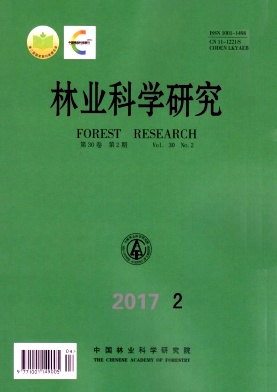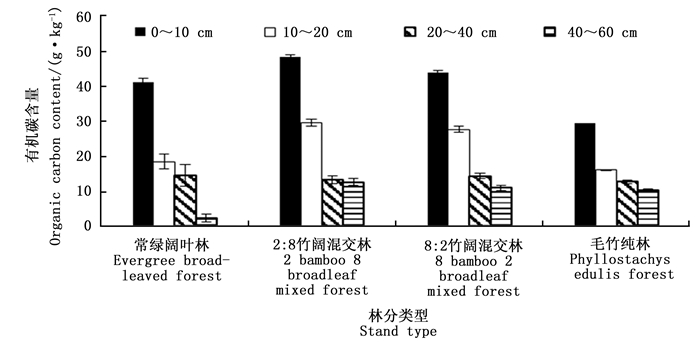-
常绿阔叶林是我国湿润亚热带地区特有的森林生态系统,蕴藏丰富的资源和生物多样性。毛竹(Phyllostachys heterocycla (Carr.)Mitford)作为一种高大散生乔木状克隆植物,依靠强大的地下茎(竹鞭)向常绿阔叶林蔓延以实现种群克隆扩张,导致常绿阔叶林演替形成竹阔混交林,甚至在人为干扰下形成毛竹纯林[1]。毛竹扩张能够引起一系列生态变化,如森林景观被破坏[2]、生物多样性锐减[3]、林地土壤退化[4]及森林碳库改变[5]等。常绿阔叶林在毛竹扩张的胁迫下,结构简化、组成成分减少、物流能流受阻、平衡状态破坏、更新能力减弱,以及生态系统服务功能的持续下降导致水土流失加剧,自然灾害频发、生物多样性减少、生态与环境质量下降[6]。近年来,常绿阔叶林受邻近毛竹林扩张的问题逐渐引起生态学家的广泛关注,但基于土壤有机碳含量和土壤性质对毛竹扩张给常绿阔叶林带来的影响尚未见报道。为此,本研究在江西省大岗山森林生态定位站,基于空间代替时间理论,选择常绿阔叶林、2∶8竹阔混交林,8∶2竹阔混交林和毛竹纯林4种林分类型为研究对象,对4种植被林下土壤有机碳和土壤物理性质、持水能力变化特征进分析,并运用相关分析方法探讨其相互关系,以揭示毛竹扩张对常绿阔叶林土壤性质的影响。旨在为我国亚热带森林植被演替方面研究提供理论支持,丰富我国南方竹林主要分布区域已有竹林扩张研究成果,为大岗山地区森林科学经营提供参考。
HTML
-
研究区位于江西大岗山国家森林生态系统野外科学观测研究站(114°30′~114°45′E,27°30′~27°50′N),属亚热带湿润气候区,年平均气温15.8~17.7 ℃,年平均降水量1 591 mm,且全年降水主要集中在4-6月。土壤属长江中下游低山丘陵红壤、黄壤类型[7]。亚热带天然常绿阔叶林为该区地带性植被,也是自然演替的顶级群落,但由于长期自然和人为干扰作用,遭到严重破坏。现存植被类型主要为次生林或人工林,包括次生常绿阔叶林、落叶阔叶林、各类针阔混交林、毛竹林、杉木人工林等[8]。
-
试验地设置在大岗山森林生态站海拔300 m区域。2014年6月,在尽量保持立地条件和经营措施一致的前提下,选取常绿阔叶林、2∶8竹阔混交林、8∶2竹阔混交林和毛竹纯林4种林分类型,每种林分各设置3个20 m×20 m标准样地,共12个样地。常绿阔叶林优势种主要为丝栗栲(Castanopsis fargesii Fr.),林下植物主要为黄牛奶树(Symplocos laurina (Retz.)Wall.)、苦槠栲(Castanopsis sclerophylla (Lindl.)Schott.)、绒毛润楠(Machilus velutina Champ. ex Benth.)、油茶(Camellia oleifera Abel.)、铁芒萁(Dicranopteris dichotoma (Thunb.)Bernh.)、淡竹叶(Lophatherum gracile Brongn.)和草珊瑚(Sarcandra glabra (Thunb.)Nakai)等;竹阔混交林由毛竹和丝栗栲组成,林下植被主要有刨花楠(Machilus pauhoi Kanehira)、山乌桕(Sapium discolor (Champ. ex Benth.)Muell.Arg.)、油茶、绒毛润楠、杜茎山(Maesa japonica (Thunb.)Moritzi.)、淡竹叶、铁芒箕和寒莓(Rubus buergeri Miq.)等;毛竹纯林下植被简单,主要有淡竹叶、油茶、毛冬青(Ilex pubescens Hook. et Arn.)和狗脊(Woodwardia japonica (L.f.)Sm.)等[9]。4种林分类型样地基本情况详见表 1。
林分Stands 林龄/(株龄)
Age/a海拔
Altitude/m坡向
Aspect林分密度
Stand density/(株·hm-2)平均胸径
Average DBH/cm郁闭度
Canopy density土层厚度
Soil thickness/cm常绿阔叶林Evergreen broad-leaved forest 45 290 东北 146 0 18.45 0.85 35 2∶8竹阔混交林2 bamboo 8 broadleaf mixed forest 40 308 东 321 4 8.95 0.75 40 8∶2竹阔混交林8 bamboo 2 broadleaf mixed forest 35 306 东 310 0 9.51 0.70 75 毛竹纯林Phyllostachys edulis forest 1~15 300 东 391 0 8.50 0.80 50 注:表中每种林分数据均为实际调查样地的加权平均值。
Note: The data of each stand is a weighted average of the actual survey plots in the table.Table 1. Polt survey
-
低分别挖掘3个土壤剖面(合计36个),用容积100 cm3的土壤环刀自上而下分别取0~10、10~20、20~40、40~60 cm土层的原状土样,每层重复3个环刀,采用烘干法测定土壤含水量,根据《森林土壤水分-物理性质的测定》(GB/T 1215-1999)行业标准[10],测定土壤密度、孔隙度和持水量等物理性质;同时,分层采集土壤样品,风干后将每个样地3个剖面土样按照自然发生层分别均匀混合,根据《森林土壤分析方法》进行过筛处理,带回实验室测定土壤有机碳含量[11]。
-
土样密度、土壤持水量采用环刀法测定;土壤孔隙度和贮水量采用计算法;土壤有机碳采用K2Cr2O7外加热法测定[10-12]。
-
采用Excel图表和SPSS13.0软件进行数据处理。
1.1. 研究区概况
1.2. 研究样地设置
1.3. 样品采集与分析方法
1.3.1. 样品采集在每个标准样地内按照海拔高
1.3.2. 室内分析
1.4. 数据处理
-
图 1表明:4种林分土壤有机碳含量变化范围为2.40~48.43 g·kg-1,各林分含量均随土壤深度的增加呈递减的趋势,其中,从0~10 cm到10~20 cm土层减少显著,20~60 cm降低幅度较小。不同林分类型相比较,2∶8竹阔混交林的有机碳含量高于另外3种林分,毛竹纯林土壤有机碳含量显著低于常绿阔叶林和2种竹阔混交林。这表明毛竹向常绿阔叶林扩张的过程中,土壤有机碳含量在混交林时期略有提高,但当完全演替成毛竹纯林后,有机碳含量逐渐降低,且明显低于常绿阔叶林时的土壤肥力水平。值得注意的是,40~60 cm土层毛竹纯林有机碳含量降低不显著,这与毛竹根系较浅,对较深层土壤养分利用率低有关。
-
由表 2可见:被调查的4种林分,土壤密度随土层深度的加深而增加;在0~60 cm土层,各林分密度表现为8∶2竹阔混交林(1.54 g·cm-3)>2∶8竹阔混交林(1.46 g·cm-3)>常绿阔叶林(1.30 g·cm-3)>毛竹纯林(1.25 g·cm-3),毛竹纯林低于常绿阔叶林和混交林。毛竹扩张不仅能够改善根系和竹鞭分布区域的土壤物理性质,同时,土壤密度也影响水肥作用,进而改善土壤微生物和酶的活性,对植物生长起更为直接的作用。与笔者预想不同,毛竹根系较阔叶树发达,土壤密度本应随毛竹含量增加而降低,但结果显示,以密度为衡量标准毛竹纯林土质最好,常绿阔叶林次之,8∶2竹阔混交林最差;可见,群落演替程度和群落林分结构变化往往并不同步,群落结构改变一方面影响土壤的理化性质,同时,土壤理化性质也反作用植物群落,因此,以群落结构为演替标准,土壤的退化过程并非同步。此外,作为顶级群落,常绿阔叶林土壤结构稳定,这或许也是其土壤密度不高的原因。
土层
Depth/cm土壤密度Soil density/(g·cm-3) 常绿阔叶林
Evergreen broad-leaved forest2∶8竹阔混交林
2 bamboo 8 broadleaf mixed forest8∶2竹阔混交林
8 bamboo 2 broadleaf mixed forest毛竹纯林
Phyllostachys edulis forest0~10 1.25cC 1.39bC 1.50aB 1.22cB 10~20 1.30cB 1.42bC 1.52aB 1.22cB 20~40 1.31bB 1.47aB 1.49aB 1.28bA 40~60 1.35cA 1.55bA 1.64aA 1.29cA 平均Mean 1.30bB 1.46bB 1.54aB 1.25bAB 注:同行不同小写字母表示不同林分间差异显著(p<0.05),同列不同大写字母表示同一林分不同土层间差异显著(p<0.05) (LSD)。
Note: Different lower case letters in same line indicate significant difference in different stand (P<0.05). Different capital letters in the same column indicate significant difference in different soil layers in the same stand (P<0.05) (LSD).Table 2. Soil density of 4 kinds of stands
由表 3可见:被调查的4种林分,0~60 cm土层,总孔隙度为毛竹纯林>常绿阔叶林>2∶8竹阔混交林>8∶2竹阔混交林;混交林的毛管孔隙度低于另外2种林分,而毛竹纯林的毛管孔隙度高于另外3种林分。0~10、10~20、40~60 cm土层的非毛管孔隙度为常绿阔叶林>2∶8竹阔混交林>毛竹纯林>8∶2竹阔混交林,常绿阔叶林高于另外3种林分;20~40 cm土层的非毛管孔隙度为常绿阔叶林>2∶8竹阔混交林>8∶2竹阔混交林>毛竹纯林。研究表明,常绿阔叶林作为亚热带的顶级群落,土壤物理性质稳定且水平较高,毛竹扩张对土壤孔隙度有影响,但当群落演替到毛竹纯林时,土壤总孔隙度和毛管孔隙度有所改善,这和毛竹竹鞭发达有关;但非毛管孔隙度仍低于常绿阔叶林,这可能与毛竹林人工干扰和挖笋等对土壤扰动有关。
林分
Stands土层
Soil/cm总孔隙度
Total porosity/%毛管孔隙度
Capillary porosity/%非毛管孔隙度
Non-capillary porosity/%常绿阔叶林
Evergreen broad-leaved forest0~10 52.82 aA 36.78 aA 16.04 aA 10~20 51.01 aA 34.90 aB 16.11 aA 20~40 50.75 aA 33.48 aB 17.27 aB 40~60 49.11 aB 33.42 aB 15.69 aC 2∶8竹阔混交林
2 bamboo 8 broadleaf mixed forest0~10 47.62 aA 35.13 cA 12.49 bA 10~20 46.53 bA 35.07 cA 11.46 bB 20~40 44.41 bA 33.29 cB 11.12 bB 40~60 41.69 bB 31.00 cC 10.69 bC 8∶2竹阔混交林
8 bamboo 2 broadleaf mixed forest0~10 43.25 bA 34.98 cA 8.27 cA 10~20 42.47 bA 34.51 cA 7.96 cA 20~40 43.92 bA 33.12 cB 10.80 bB 40~60 38.16 cB 32.63 cB 5.53 cC 毛竹纯林
Phyllostachys
edulis forest0~10 54.03 aA 44.50 bA 9.53 abA 10~20 53.90 aA 45.16 bA 8.74 cA 20~40 51.57 aB 43.72 bB 7.85 bB 40~60 51.25 aB 44.68 bA 6.57 cC 注:同林分不同小写字母表示不同土层间差异显著(p<0.05),同列不同大写字母表示不同林分间差异显著(p<0.05) (LSD),下同。
Note: Different lower case letters in same stand indicate significant difference in different soil layers (P<0.05). Different capital letters in the same column indicate significant difference in different stand (P<0.05) (LSD). The same below.Table 3. Soil physical properties in 4 stands
-
表 4表明:随土壤深度的加深,常绿阔叶林、2∶8竹阔混交林、8∶2竹阔混交林和毛竹纯林的土壤层饱和持水量、毛管持水量和非毛管持水量呈下降的趋势;8∶2竹阔混交林的饱和持水量和非毛管持水量在20~40 cm土层中增加,到40~60 cm土层中又降为该林分饱和持水量和非毛管持水量的最低值;毛竹纯林的毛管持水量随土层变化无明显的变化规律。0~60 cm土层的饱和持水量、毛管持水量均为毛竹纯林>常绿阔叶林>2∶8竹阔混交林>8∶2竹阔混交林;0~60 cm的非毛管持水量为常绿阔叶林>2∶8竹阔混交林>毛竹纯林>8∶2竹阔混交林。研究表明,毛竹扩张对常绿阔叶林的持水功能有所改善,特别是可被植物利用的毛管持水量有所增加,为植物提供了必需的水肥条件,对植物的生理功能影响较重要,也相应增强了各种酶的活性;但是,非毛管持水量作为土壤中水分快速储藏途径,常绿阔落叶林仍居4种被调查林分之首,作为当地顶级群落,常绿阔叶林土壤在快速减缓径流方面表现更佳。由于不同土层取样厚度不同,现有贮水量和饱和贮水量随深度没有可遵循的变化规律,不同林分间现有贮水量表现为毛竹纯林>8∶2竹阔混交林>常绿阔叶林>2∶8竹阔混交林;饱和贮水量则为毛竹纯林>常绿阔叶林>2∶8竹阔混交林>8∶2竹阔混交林。
林分
Stands土层
Soil/cm饱和持水量
Saturated water holding capacity/%毛管持水量
Capillary water holding capacity/%非毛管持水量
Non-capillary water holding capacity/%现有贮水量
Existing storage capacity/(t·hm-2)饱和贮水量
Saturated water storage/(t·hm-2)常绿阔叶林
Evergreen broad-leaved forest0~10 42.25 aA 29.42 aA 12.83 aA 265.35 aA 528.20 aA 10~20 39.29 aA 26.88 aB 12.41 aA 257.55 aA 510.10 aA 20~40 38.89 aA 25.65 aB 13.23 aA 481.89 aB 1 015.00 aB 40~60 36.42 aB 24.78 aB 11.63 aB 522.09 aB 982.20 aB 2∶8竹阔混交林
2 bamboo 8 broadleaf mixed forest0~10 34.31 bA 25.31 aA 9.00 bA 287.58 aA 476.20 bA 10~20 32.84 bA 24.75 aA 8.09 bB 275.05 aA 465.30 aA 20~40 30.15 bB 22.60 aB 7.55 bB 400.73 aB 888.20 bB 40~60 26.98 bC 20.06 aC 6.92 bB 300.67 bC 833.80 aB 8∶2竹阔混交林
8 bamboo 2 broadleaf mixed forest0~10 28.76 cA 23.26 aA 5.50 cA 243.29 aA 432.50 bA 10~20 27.86 cA 22.64 aA 5.22 cA 298.77 bA 424.70 aA 20~40 29.55 bA 22.29 aA 7.27 bB 490.33 aB 878.40 bB 40~60 23.29 bB 19.91 aB 3.37 cC 545.65 cB 763.20 bB 毛竹纯林
Phyllostachys edulis forest0~10 44.35 aA 36.53 bA 7.82 bA 314.54 bA 540.30 aA 10~20 44.12 abA 36.97 bA 7.15 bA 304.55 bA 539.00 aA 20~40 40.18 aB 34.07 bB 6.12 bB 629.10 bB 1 031.40 aB 40~60 39.67 aB 34.59 bB 5.09 bC 443.16 bC 1 025.00 aB Table 4. The change feature of soil moisture in 4 stands
-
表 5表明:土壤有机碳含量与土壤总孔隙度呈显著正相关,与土壤密度、非毛管持水量和现有贮水量呈显著或极显著负相关,与其它相关变量相关性不显著。土壤物理性质和水分各指标间也存在不同程度的相关关系,土壤密度与总孔隙度、毛管孔隙度、饱和持水量、毛管持水量呈极显著负相关,与非毛管持水量成显著正相关;而土壤总孔隙度与毛管孔隙度、饱和持水量、毛管持水量呈极显著正相关,与非毛管持水量呈显著负相关;毛管孔隙度与饱和持水量、毛管持水量呈极显著正相关;饱和持水量与毛管持水量呈极显著正相关,与非毛管持水量呈显著负相关。
项目
Project有机碳含量
Content of organic carbon土壤密度
Soil density总孔隙度
Existing storage capacity毛管孔隙度
Capillary porosity饱和持水量
Saturated water holding capacity毛管持水量
Capillary water holding capacity非毛管持水量
Non-capillary water holding capacity现有贮水量
Existing storage capacity有机碳含量Content of organic carbon 1 土壤密度Soil density -0.53* 1 总孔隙度Existing storage capacity 0.50* -0.99** 1 毛管空隙度Capillary porosity 0.04 -0.73** 0.72** 1 饱和持水量Saturated water holding apacity 0.41 -0.97** 0.99** 0.74** 1 毛管持水量Capillary water holding capacity 0.05 -0.88** 0.87** 0.97** 0.89** 1 非毛管持水量Non-capillary water holding capacity -0.82** 0.52* -0.54* -0.20 -0.51* -0.06 1 现有贮水量Existing storage capacity -0.69** 0.07 -0.07 -0.06 -0.06 -0.02 0.17 1 注:表中*表示P<0.05,**表示P<0.01。
Note: * indicate P<0.05,** indicate P<0.01。Table 5. Correlation between soil organic carbon and soil properties
2.1. 土壤有机碳含量变化特征
2.2. 土壤密度与孔隙度变化特征
2.3. 土壤水分变化特征
2.4. 土壤有机碳含量与土壤其他特征的相关分析
-
在毛竹向常绿阔叶林扩张过程中,4种被调查林分的土壤有机碳含量先增加后降低。不同林分类型相比较,2∶8竹阔混交林的有机碳含量高于另外3种林分,毛竹纯林的土壤有机碳含量显著低于常绿阔叶林和2种竹阔混交林。根据图 1,常绿阔叶林0~60 cm土层的土壤有机碳含量平均为19.20 g·kg-1,2∶8竹阔混交林增长到25.99 g·kg-1,8∶2竹阔混交林有机碳含量平均为24.32 g·kg-1,毛竹纯林则降为17.15 g·kg-1,比常绿阔叶林下降了10.67%,这与杨清培等[5]的研究结果一致。土壤有机碳的变化不仅与毛竹扩张过程中形成混交林直至演替成纯林样地中植被种类变化相关,也受土壤密度、孔隙度和水分的贮持能力密切影响;相关性分析表明,土壤有机碳含量与土壤总孔隙度成显著正相关,与土壤密度、非毛管持水量和现有贮水量呈显著或极显著负相关。
大岗山生态站研究区域均为林龄较高的次生常绿阔叶林,凋落物层较厚,土壤肥沃,有机碳含量较高,常绿阔叶林表层土壤孔隙度和持水量均较高,为扩张后竹笋萌发提供了充足的养分、水分来源。宋庆妮等[13]的研究结果表明,毛竹扩张对土壤氮素的矿化是毛竹成功扩张的另一个原因,在常绿阔叶林逐渐演替成毛竹纯林的过程中,土壤氮素氨化作用增强,产生的大量铵态氮,进一步满足了毛竹生长发育对土壤氮素的需求,而随着林地毛竹比例增加,土壤硝化作用和总矿化作用下降,不能满足常绿阔叶林对大量土壤硝态氮和无机氮的需求,影响了常绿阔叶林的生长。因此,土壤碳氮含量以及土壤密度、孔隙度和水分特征可能是控制毛竹林扩张,维持常绿阔叶林作为顶级群落稳定性的重要生态策略,但是,空间代替时间的方法不能完整还原常绿阔叶林向毛竹纯林演替过程,其机理也更为复杂,需进一步研究。
-
原先阔叶树的林分土壤密度高于毛竹纯林,土壤孔隙度、持水量较低,进而影响土壤水肥的运输和通气性能,降低植物对养分的利用;毛竹在扩张过程中为了吸收营养物质,依靠强大的地下竹鞭不断扩张到常绿阔叶林生态系统,导致林内部分木本植物竞争失败而死亡,增加了竹阔混交林土壤有机碳来源,促进竹阔混交林土壤有机碳含量的增加;但由于毛竹无性繁殖的特点,对土壤有机碳消耗巨大,当常绿阔叶林完全演替到毛竹纯林后,原来常绿阔叶林林下植被大部分已消失殆尽,再加上择伐、挖笋等人类活动的影响,地上、地下碳源大量减少,从而导致土壤有机碳归还降低,有机碳含量逐渐下降。







 DownLoad:
DownLoad: